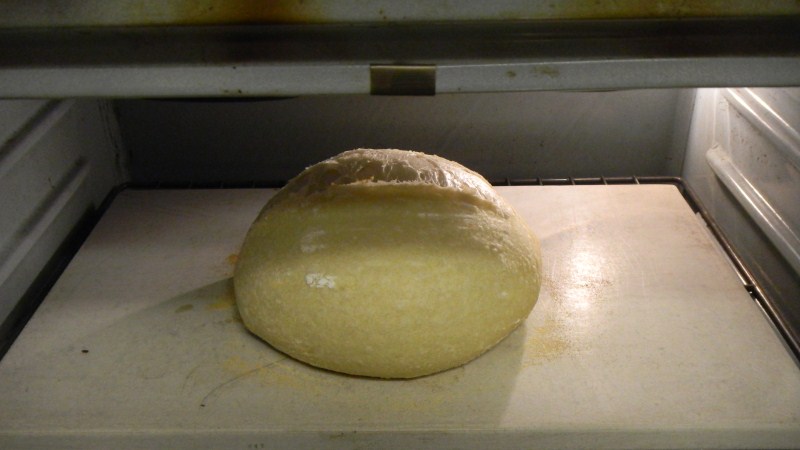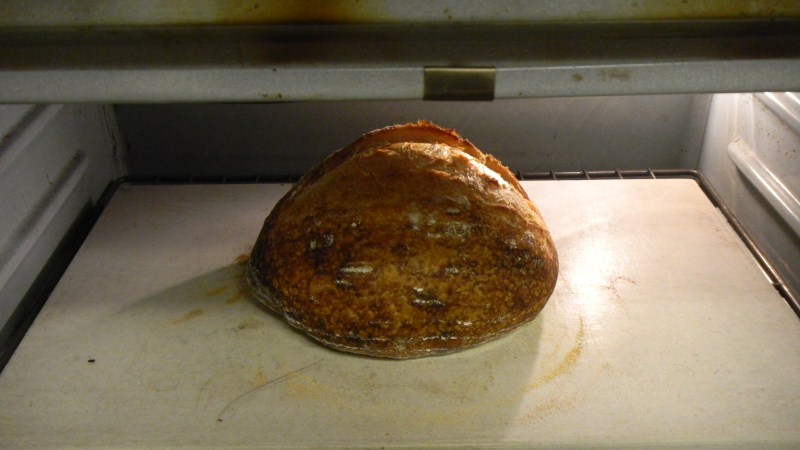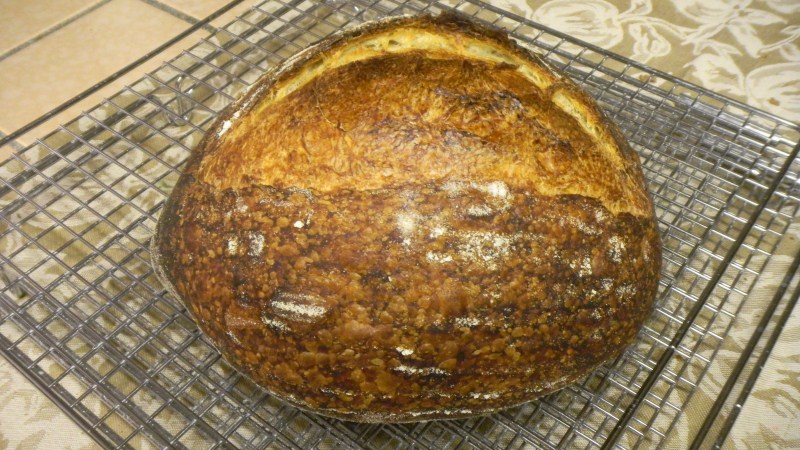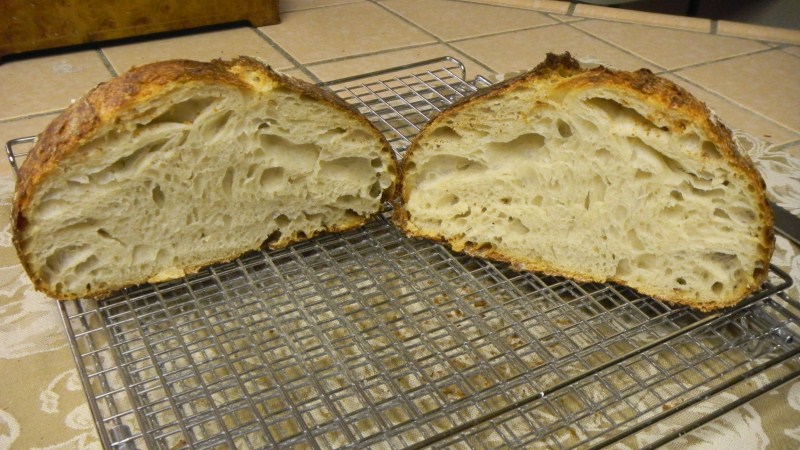Hello,
I wanted to try out a schedule that worked for my normal work-week and maximizing
flavor, because I am usually not around during the daytime hours. Also I
wanted to see the effect of a purely white flour mash.
Due to the way my schedule works, I did bulk ferment of 24 hrs, with the understanding
that my final dough might be sour (hopefully not inedible sour),
So for this recipe I was going for 100% white flour. For my palette, a white
bread with a solid tang is good. Maybe not so much tang for breads with a high
percentage of whole grains.
Turns out, this was perfect (for me). I would make this again. Tastes great!
All flour is KA Bread Flour, except for the starter flour which is KA AP.
All weight in grams.
Total Dough Weight: 1000
Total Dough Hydration: 68%
Total Dough Flour Weight: 595
Total Dough Water Weight: 405
Percentages:
Levain Percentage: 20%
Levain Hydration: 125%
Starter Percentage: 10% of leaven
Starter Hydration: 125%
Soaker Percentage: 54%
Soaker Hydration: 80%
Mash Percentage: 20% of soaker
Mash Hydration: 200%
Soaker Salt Percentage: 1%
Overall Dough Salt Percentage: 1.5%
Levain:
Flour Weight: 114
Water Weight: 143
Starter Weight: 12
Mash:
Flour Weight: 64
Water Weight: 128
Diatastic Malt Powder: 1
Soaker:
All Mash:
Flour Weight: 257
Water Weight: 129
Salt Weight: 3
Final Dough:
All Levain
All Soaker/Mash
Flour Weight: 155
Salt: 6
Procedure I did:
1) Evening #1, made mash. I did 55C for 90 mins, 60C for 30 mins,
65C for 30 mins, 70C for 30 mins.
2) Morning #2, mixed levain and soaker/mash.
3) Evening #2, mixed everything to final dough. Put dough into
chiller at 44F / 6.6C.
4) Morning #3, stretch + fold.
5) Evening #3, took dough out of chiller, another stretch + fold.
6) Final of evening #3:
Allowed 1 hr for warm-up.
Shaped. Cut out a small chunk of dough to watch bubble activity.
It took 2.5 hours for dough to be ready for bake -- Both from bubble activity
and feel of the dough. I am getting better at gauging the feel of the dough,
and not needing the crutch of watching bubble activity, but it is good to have
the small chunk of dough as a confirmation.
Turns out, I am still staying up too late on Evening #3, because it takes a while
for the dough to do the final ferment after being the chiller for so long.
But, I can make bread during the week! :)
Pictures:
Oven after first 10 minutes of steam:

Baked with steam (above) for 10 mins at 460F, then lowered to 420F. Here it is after 20 mins at 420F.

A little bit darker than I'd like, but all good. Internal temp measured 207F and was hollow to the thump.


Crumb:



Happy baking!
- sam's Blog
- Log in or register to post comments
Looking only at the picture I was almost sure that you made a 100% durum wheat bread, instead...
Very nice looking loaf. Can you explain if you prepared the soaker mixing the mash with flour, cold water and salt? I didn't understand that passage.
Nico
I've never tried a Durum bread, does this look like one?
Yes, the cold flour soaker was prepared with the contents of the mash, and more flour/water/salt, left to soak while the levain was fermenting at room temp. At 200% mash hydration, there is enough liquidity to reuse the water in the mash for a subsequent flour soaker. Works perfectly.
yes, certain types of durum wheat breads look very much like yours.
Great White mash bread , gvz! lovely looking crust and crumb. I never tried mashing before. i should one day, thanks to you :)
Nico, KA brad flour has a quite high protein content 13% or so. The strength of the dough is similar t0 those made of durum high protein flours.
Love the colour of the crust! And the crumb!!! Absolutely beautiful. :)
Haven't baked 100% white for aaaaaaaaaaages. Even my basic baguette has rye and WW in it. Maybe I should go back to more basics once in a while to enjoy the pure taste of white flour....I mean the wheat kind....not the one you buy discreetly in the darkness of some back streets....:p
Never tried mash, either. Very intruiging, too.
Thank you for sharing, gvz.:)
lumos
First an 80% rye, then a 100% white. Great baking across the spectrum. -Varda
Thanks Khalid, lumos and Varda.
Here is one more pic from this morning after it had rested. (apologies for the yucky sponge in the background, was cleaning up..). Very moist, tender and tasty! Yum!
Hi gvz,
The write-up of your procedure is really interesting and the photographs are great.
I take it that your worries about excess sourness in the taste were not realised? I have had difficulties with long retarded doughs coming back to ambient temperature too; it can take quite some time.
Above all; lovely bread!
Best wishes
Andy
Thanks Syd and Andy!
Turns out, it wasn't too sour for my taste preference for this type of bread. Just right.
And not too much actual "work", fortunately time does most of it. Mashing isn't hard to do at all, the PID temperature controller makes it easy. I've been keeping my mash concentrations to between 10-12% of the total bread. They are very sweet and add great flavor to the bread, without impacting crumb structure or resulting in "gummyness" at all. It does make the crumb + crust a little softer than without, but I like that. I usually put the mash in the fridge overnight to cool down before turning it into a flour soaker the next morning. I think reusing the mash in the soaker is good because you can soak more total flour than if you tried to do a mash and a soaker independently, given the overall dough hydration constraints.
I've pretty much narrowed down a set of generic formulas for levain/mash+soaker. A 68% overall hydration for white+mostly-white breads. A 73% hydration for half-whole grain/half-white, and a 75% hydration for 80% or higher whole grains. (Except for the high concentration Rye's, that is a separate animal). In all the formulas except for the high Rye's, I keep 20% as the levain at 125% hydration, the flour soaker ranging from 54% to 63% of flour at 80% hydration, with 20% of the flour soaker being the mash (at 200% hydration initially). All of the water of the doughs are either in the levain or soaker/mash. The final mix is just a bit more flour and salt. The chilled bulk ferment time is either 12 or 24 hrs depending on my schedule and/or how much sour I am looking for. I prefer less sour for the higher percentage whole grains. I usually ferment my levain at room temp, which takes appx 10 hours for me, but if I really want an intensely sour bread, I will ferment my levain for 24 hrs at a cold temp.
I think I am finally getting the hang of this! You guys (as well as most people here) are far more experienced bakers than me, but I'm sure in the past you must have gone through a phase of, "Wow, this is the best bread I ever tasted." Then a few days later: "Wow, this is the best bread I ever tasted." Love it! :-)
Got a new toy last week -- a large marble workboard. It works much better than a plain wooden one for the stickier higher hydration doughs, for me anyway.
Cheers!
This is probably a bit speculative since I have no microscope or the knowledge/skill set to interpret what I would see, but another thing I think has helped a lot for flavor, is exposing my starter to a wide variety of food. I mill all of my whole-grains at home. This past couple months, I've been feeding my starter mixtures of AP flour + whole-grain flours. Been feeding it whole rye, whole wheat, whole spelt, whole barley, and lately, whole einkorn. I also have some buckwheat but haven't fed it any of that. I have no direct evidence, but I am hoping my starter has picked up a wider variety of wild yeasts and LAB than otherwise.